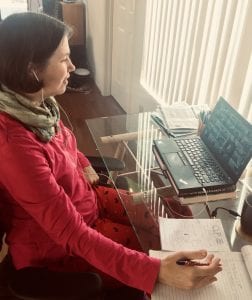 By Kris Palmer
By Kris Palmer
So much of the dynamism that emerged early this semester in my American Government class came from the community college students talking with one another or with me — from the energy of human connection.
Our classroom was alive with debate teams and group problem-solving. Students drew energy and encouragement from one another as they worked in pairs to analyze documentary clips and readings. A food table in class helped ensure no one was hungry while trying to learn. Halfway through our 16 weeks together, we were building a community. Boom: circumstances changed overnight.
The hardest part of teaching the class online, which I began doing on March 16, as mandated while California’s shelter-in-place order is in effect, has been missing our budding community. How will I get the critical nonverbal information I receive when I am face-to-face with students? I think I get to know them better in person and can better tailor curriculum and pedagogy with that information in mind. Perhaps as important: How will students support one another in this “new normal”?
A sense of belonging makes learning easier. Brain researchers say it is essential to deep learning, something I took away from an education conference last fall.
So now I am looking for ways my students can make connections and all feel they belong to a virtual group. Of the many questions I posed to them in our first meeting this week, the question that seemed to connect us all best was, “What can you do to help people in our class?”
Many drew from their own strengths and skills (these aren’t their real names): Barbara said she would help make people laugh. Elisha said the best thing we can do for each other is keep our distance. Michael, who works as a community organizer, offered links and times for online town hall discussions where East Bay residents are voicing their opinions about housing and evictions during the pandemic. I said, “OK, I’ll create a discussion board for the class so we can keep sharing links and ideas.” Tirrell said he can offer us reassurance: It’s not easy now, but we will get through this time together.
After Tirrell shared, I thought I felt a sense of calm fall over the group. Aisha said she had just filed for unemployment and could give tips to others. Kenia shared wishes for calm and said she feels better knowing we’re all in this boat together. Dan offered himself as someone people could talk to if they feel bored or worried or just want to connect. Joanna offered links to healthy recipes and workouts. With a term paper deadline coming up in two weeks, Barbara reminded everyone that she could help people who struggle with their writing.
Several students did not have their cameras turned on — or do not have cameras. Many barely spoke unless I addressed them directly. I couldn’t stand near them or meet their eyes and nod to encourage them to take the chance and speak. Some students have yet to speak though I see their names on my gallery Zoom screen. In our brick-and-mortar classroom, I can observe that students are listening, and we acknowledge one another with eye contact.
A handful of students have not attended since we went online, despite many attempts to reach them. I’m most worried about these students and am working with my college to keep trying to contact them. We are still looking for ways to overcome new barriers that have arisen for students already juggling so much.
As I seek out training and tips for creating connections in a virtual space, I grieve the loss of seeing all their faces in person. And I appreciate how most are focusing on their studies even when there are a thousand reasons to give up or succumb to distractions or discomforts — and, worse, when some students have no choice but to quit college right now.
As the class studies the responses from our national and state governments’ executive and legislative branches to what could be the largest global pandemic in modern history, we will communicate through Zoom video conferencing; we will continue as we always have with the Canvas platform for discussions, assignments, and studio; and of course, we continue to use old-fashioned email for a few things. Students seem to like “Zoom rooms” best; they get to relate to one another in small groups and analyze problems together for part of the class. I’m grateful for all of these tools and, most of all, for the students and for the opportunity to learn and belong together.
Kris Palmer is a senior director with Career Ladders Project and an adjunct faculty member at Chabot College in Hayward, Calif.